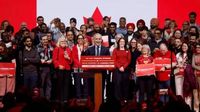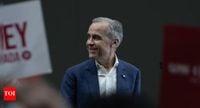In a stunning political turnaround, Mark Carney has led the Liberal Party to victory in the 2025 Canadian federal elections, marking the first time a party has retained power for a fourth consecutive term in the country’s history. Carney's ascent to the prime ministership comes after a tumultuous period characterized by soaring costs of living and the looming threat of U.S. tariffs under President Donald Trump.
The political landscape shifted dramatically when former Prime Minister Justin Trudeau announced his resignation on January 6, 2025. At that time, the Conservatives, led by Pierre Poilievre, held a commanding lead of over 20 points in most polls. Voter dissatisfaction with Trudeau’s decade in power, particularly regarding rising costs, fueled this shift.
Despite the initial polling disadvantage, Carney, who had previously served as the Governor of the Bank of Canada and the Bank of England, entered the race with a platform that resonated with voters. He framed the election as a battle against Trump’s aggressive trade policies, stating, “The Americans want to break us so they can own us. Those aren't just words. That's what's at risk.” This message struck a chord with many Canadians, leading to a record 7.3 million ballots cast before election day.
The election results, which were finalized on April 29, 2025, showed that while the Liberal Party did not secure a majority, they emerged as the leading party with the most seats, paving the way for a minority government. Carney expressed gratitude to his campaign team, tweeting, “For 37 days, in every corner of this country, our team worked to build a stronger Canada. Thank you to everyone who put so much into this campaign.”
Carney’s victory is particularly notable given the context of the political environment leading up to the election. The Conservative Party had been riding high in the polls, capitalizing on public discontent over economic issues, including a cost-of-living crisis that had been exacerbated by Trump’s tariff threats. In the face of this adversity, Carney’s anti-Trump stance became a rallying point for voters who feared the implications of U.S. policies on Canadian sovereignty and economic stability.
In his victory speech, Carney reiterated his commitment to addressing the pressing issues facing Canadians, stating, “I joined politics because I felt that Canada needed big changes.” He emphasized values of humility, ambition, and unity, which he believes will guide his administration as it navigates the complexities of governing a nation facing significant economic challenges.
One of the critical factors in the election was the performance of the New Democratic Party (NDP), led by Jagmeet Singh, who announced his resignation following disappointing results. The NDP is projected to win only eight seats, a significant decline from previous elections. Singh had previously managed to keep Trudeau’s minority government afloat through a supply agreement, but the shift in voter sentiment has left the NDP struggling to maintain its foothold in Canadian politics.
The election also highlighted the importance of key ridings, particularly in regions like Burnaby Central, British Columbia, where the NDP’s previous leader had held sway. This riding was a litmus test for the left-leaning vote, and while Singh campaigned vigorously, he found himself trailing behind as left-leaning voters consolidated their support behind the Liberals.
In Ontario, ridings such as Aurora—Oak Ridges—Richmond Hill and Burlington played pivotal roles in determining the election outcome. The Conservatives had previously held these areas, but the Liberal resurgence in the polls indicated a potential shift in voter preferences driven by economic concerns and dissatisfaction with U.S. policies.
In Quebec, the Bloc Quebecois remained a formidable force, with ridings like Trois-Rivieres showcasing the tight race among multiple parties. The Bloc narrowly won the previous election, and its performance remained crucial for any party hoping to form a government.
As Carney prepares to govern, he faces the daunting task of addressing the economic challenges posed by U.S. tariffs, which threaten to undermine Canada’s export-driven economy. With more than 75% of Canadian exports heading to the U.S., the stakes are high. Carney’s administration will need to negotiate effectively with other parties in Parliament to pass legislation, as the minority government will require support from other political factions to implement its agenda.
Looking ahead, the Liberal Party's future will depend on its ability to navigate these challenges while maintaining public support. Carney’s leadership style, characterized by a focus on collaboration and unity, will be crucial in fostering the necessary alliances to govern effectively.
In summary, Mark Carney’s election as Canada’s 25th Prime Minister marks a significant moment in Canadian politics, reflecting the electorate’s desire for change and a response to the pressures exerted by international relations. As he embarks on this new chapter, Carney will need to harness the momentum of his victory to address the pressing issues facing Canadians while building a government that reflects the diverse needs of its constituents.





